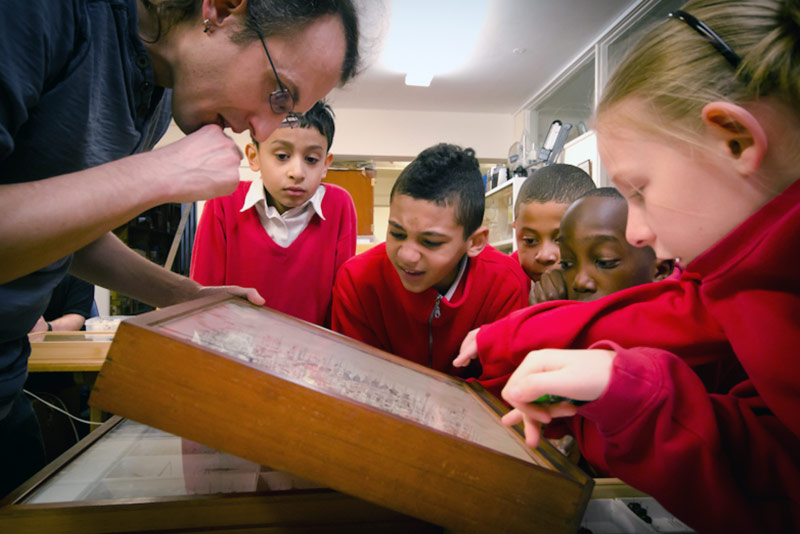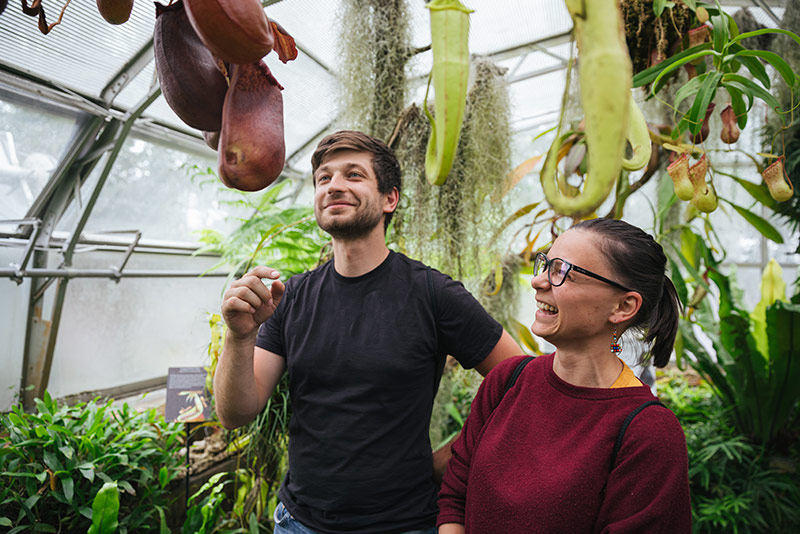Teaching in, reaching out
The University’s gardens, libraries and museums play a vital role in engaging with the public and in supporting teaching and research at all levels. Philanthropy is helping to ensure these resources are made accessible in order to inform and inspire a wide range of audiences.
HOPE for the Future
The Oxford University Museum of Natural History is renowned for its breath-taking Victorian neo-gothic architecture and galleried cloisters, brimming with fascinating specimens from the natural world. The collections it holds behind closed doors are equally intriguing. The British Insect Collection, part of the Hope Entomological Collections, is a cornucopia of 1.1 million specimens. It is a valuable research tool which spans almost the entire history of British entomology, representing a vast store of information on the biodiversity of Britain and documenting how it has changed during and after the Industrial Revolution.
Although used frequently by graduate students and visiting academics, much of the collection is currently inaccessible to the public. With support from the National Lottery Heritage Fund (NLHF) to enable a development phase, the HOPE for the Future programme has already helped reconnect people with their natural heritage, opening up these hidden treasures with tremendous results.
 A school visit to the British Insect Collection at the Oxford University Museum of Natural History. Photo courtesy of OUMNH
A school visit to the British Insect Collection at the Oxford University Museum of Natural History. Photo courtesy of OUMNH
The development phase included a range of outreach activities such as HOPE insect discovery days for schools, an Insect Investigators summer school, and a pilot Move a Million project working with volunteers to look at the re-curation of the British Insect Collection. Feedback was overwhelmingly positive from teachers, children and volunteers.
The success of the development phase has since resulted in a generous delivery phase grant of £703,700 from the NLHF to help safeguard the British Insect Collection, support a major education and community outreach programme, and create a new multi-purpose public space through the refurbishment of the historic Westwood Room.
Janet Stott, Deputy Director and Head of Public Engagement at the Oxford University Museum of Natural History, says: ‘HOPE for the Future has allowed us to demonstrate the essential role our collections play in inspiring and supporting diverse new generations of scientists, and in world-leading research. Thanks to National Lottery players, we look forward to expanding this work further to deepen understanding and ignite fascination of the natural world amongst the public.’
Engaging with objects
With the support of numerous donors, the Ashmolean Museum underwent a major physical transformation during the Oxford Thinking Campaign. It reopened in October 2009 to wide acclaim, with a focus on connections transcending geography and chronology.
In addition to doubling the display area, the redevelopment also enabled the museum to reconsider its academic relationship with the University. In 2012, the Ashmolean University Engagement Programme, generously funded by the Andrew W Mellon Foundation, was established to reimagine the museum’s potential as a resource for academic engagement at Oxford, encouraging the development of university teaching rooted in the Ashmolean’s extraordinary collections.
‘The Ashmolean’s amazing collections represent an equally and uniquely diverse and agile resource’
Since then, new classes, courses and cross-disciplinary partnerships have broadened the range of subjects that regularly employ object-centred learning, including medieval and modern languages, geography, Tibetan studies, mathematics, anthropology, medicine, business and English literature. The museum now delivers over 500 classes, seminars and tutorials every year, attended by upwards of 4,000 students.
As well as enhancing the degree programmes of Oxford students, the Ashmolean has also become a key centre for faculty members and early-career scholars to develop their skills as teachers. The Ashmolean Faculty Fellowship programme embeds academics in the curatorial departments in order to research the collections and develop new, museum-focused courses.
Led by Andrew W Mellon Teaching Curator Dr Jim Harris, the Ashmolean’s academic engagement programmes also form a key part of the museum’s commitment to diversity, equality and inclusion. Dr Harris says: ‘For a culturally and socially diverse student body, the Ashmolean’s amazing collections represent an equally and uniquely diverse and agile resource, drawing out otherwise disregarded or less-audible voices. The object-centred classroom is a fundamentally democratic space where the object can serve as a starting point and focus for exciting, inclusive teaching and learning in any discipline.’
Nurturing growth
The Oxford Botanic Garden and Arboretum (OBGA) have been much-loved features of the Oxford landscape for many years. Founded in 1621, the Oxford Botanic Garden is the oldest botanic garden in the UK, and houses approximately 5,000 different types of plants, including many critically endangered species. Harcourt Arboretum was acquired by the University in 1947 and contains some of the finest North American conifers in the UK, including giant coastal redwoods.
OBGA plays a vital role in research and teaching in plant sciences, plant conservation, and as a platform for public engagement to inform and inspire people about the importance of plants to all life on earth.
 Inside one of the glasshouses at the Oxford Botanic Garden. Photo by Ian Wallman
Inside one of the glasshouses at the Oxford Botanic Garden. Photo by Ian Wallman
Support from the Friends of OBGA underpins the mission to share the scientific wonder and importance of plants with the world. Membership of the Friends has almost doubled over the past decade. During that time, the group has been instrumental in raising funds for key areas of collections development for research and education, and for public engagement projects including visitor trails, family-friendly events, interpretation boards and the recently opened Herbarium Room
Simon Hiscock, Director of the OBGA, says: ‘OBGA has been able to offer so much more to the University and the public alike, thanks to support from the Friends. The visitor experience has been transformed over the past few years and, with our 400th anniversary in 2021, we are committed to upgrading our facilities further. We have bold plans to redevelop the glasshouses and provide more all-weather public spaces (including a café) at the garden, while at the arboretum the Friends’ campaign for the 400th anniversary seeks to raise funding to renovate the path network, as part of an NLHF bid for a new visitor and education centre.’
Support the museums and collections